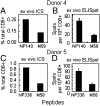Systematic identification of immunodominant CD8+ T-cell responses to influenza A virus in HLA-A2 individuals
- PMID: 21562214
- PMCID: PMC3107317
- DOI: 10.1073/pnas.1105624108
Systematic identification of immunodominant CD8+ T-cell responses to influenza A virus in HLA-A2 individuals
Abstract
Immunodominant T-cell responses are important for virus clearance. However, the identification of immunodominant T-cell peptide + HLA glycoprotein epitopes has been hindered by the extent of HLA polymorphism and the limitations of predictive algorithms. A simple, systematic approach has been used here to screen for immunodominant CD8(+) T-cell specificities. The analysis targeted healthy HLA-A2(+) donors to allow comparison with responses to the well-studied influenza matrix protein 1 epitope. Although influenza matrix protein 1 was consistently detected in all individual samples in our study, the response to this epitope was only immunodominant in three of eight, whereas for the other five, prominent CD8(+) T-cell responses tended to focus on various peptides from the influenza nucleoprotein that were not presented by HLA-A2. Importantly, with the four immunodominant T-cell epitopes identified here, only one would have been detected by the current prediction programs. The other three peptides would have been either considered too long or classified as not containing typical HLA binding motifs. Our data stress the importance of systematic analysis for discovering HLA-dependent, immunodominant CD8(+) T-cell epitopes derived from viruses and tumors. Focusing on HLA-A2 and predictive algorithms may be too limiting as we seek to develop targeted immunotherapy and vaccine strategies that depend on T cell-mediated immunity.
Conflict of interest statement
The authors declare no conflict of interest.
Figures





References
-
- Rimmelzwaan GF, et al. A randomized, double blind study in young healthy adults comparing cell mediated and humoral immune responses induced by influenza ISCOM vaccines and conventional vaccines. Vaccine. 2000;19:1180–1187. - PubMed
-
- Oukka M, et al. Protection against lethal viral infection by vaccination with nonimmunodominant peptides. J Immunol. 1996;157:3039–3045. - PubMed
-
- McElhaney JE, et al. T cell responses are better correlates of vaccine protection in the elderly. J Immunol. 2006;176:6333–6339. - PubMed
Publication types
MeSH terms
Substances
LinkOut - more resources
Full Text Sources
Other Literature Sources
Research Materials

